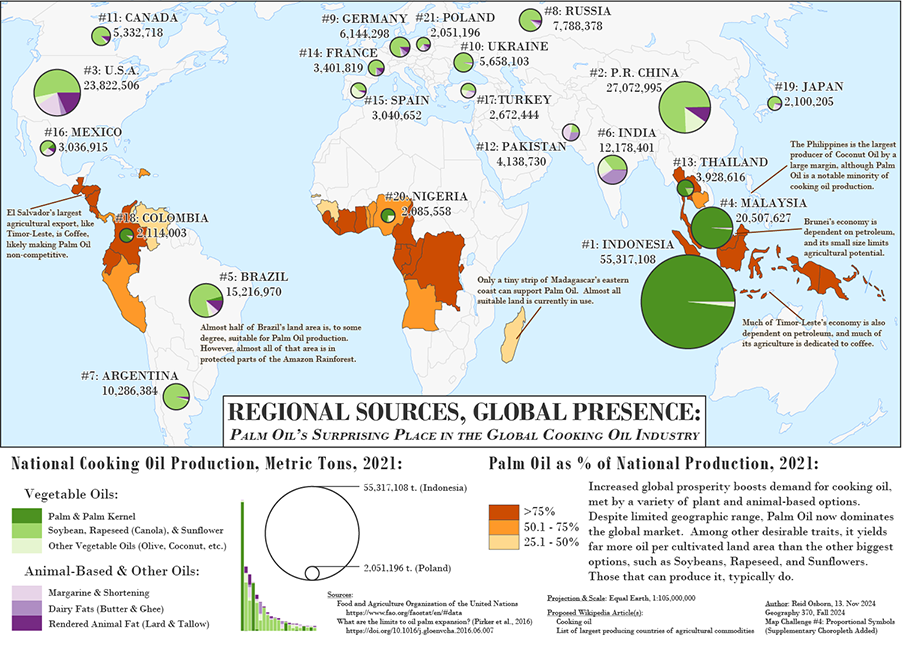Regional Sources, Global Presence
Palm Oil's Surprising Place Within Global Cooking Oil Production
How often do we really think about cooking oil? For much of the developed world, cooking oil is a matter of preference, consumer choice, environmental ethics, etc. For most of human history, and much of the world still, cooking oil is a matter of survival. It makes food more palatable, calorie dense, and unlocks production and storage methods; some foods are only edible thanks to cooking oil. In the last quarter-century, the Oil Palm has exploded onto the scene, being a driving force of deforestation, and has become a cornerstone of the global cooking oil market, despite being geographically restricted. Palm oil is solid at room temperature, has a gentle flavor, encouraging nutritional properties, and has a high smoke point, making it incredibly versatile. On top of all this, it is possibly the most land-efficient cooking oil in the world, yielding far more oil, per cultivated area, than all the other major cooking oils.
Palm oil (which comes from the fruit of the plant) and Palm Kernel oil (which comes from the seed) are so desirable and in-demand that the two top producers of Oil Palm, Indonesia and Malaysia, respectively, are the #1 and #4 global producers of cooking oil. In 2021, Indonesia made 4 million more metric tons of Palm Oil than China and the USA, the #2 and #3 global producers of cooking oil, made of all cooking oils, combined. Malaysia, despite being far smaller than Indonesia, made 5 million more metric tons of Palm Oil than Brazil, the #5 global cooking oil producer, did of all cooking oils, including Palm. Generally speaking, if a country can make Palm Oil, it does.
Originally, this project was meant to examine the top 20 producers of cooking oil, as different countries (with different economies, climates, and cultures) produce different commodities. The USA, China, and Brazil are the leading global producers of rendered animal fat, having probably the largest-scale animal agriculture operations in the world. The United States and... Pakistan, of all countries, lead the world in the production of margarine and shortening. Ukraine and Russia (until the disruption of the 2022 invasion) produced the vast majority of Sunflower Oil, favored in Africa. India is the leading global producer of ghee (butter with the solids removed), by a huge margin, but produces almost no animal fat, because of cultural taboos. Spain is a colossus of olive oil.
I wanted to break down these data by pie charts within proportional symbols, using green for plant-derived oils and purple for both animal-derived oils and margarine/shortening, which doesn't neatly fit into either column. However, once I saw the sheer impact that palm oil made, I knew I had to do a little more digging.
Still, many countries that are ecologically suitable for Oil Palm production aren't massive producers of cooking oil, or, for some reason, don't produce it. To visualize these data, I decided to add a choropleth map, visualizing the countries that had made the largest proportional commitments to Oil Palm production, and found some interesting tidbits, which I addressed with text annotations. One day, I'd like to get more in-depth on this subject.
Credits:
Created via ArcGIS Pro & Adobe Illustrator
Sources:
Food and Agriculture Organization of the United Nations
Pirker et al., 2016 What are the limits to oil palm expansion?
